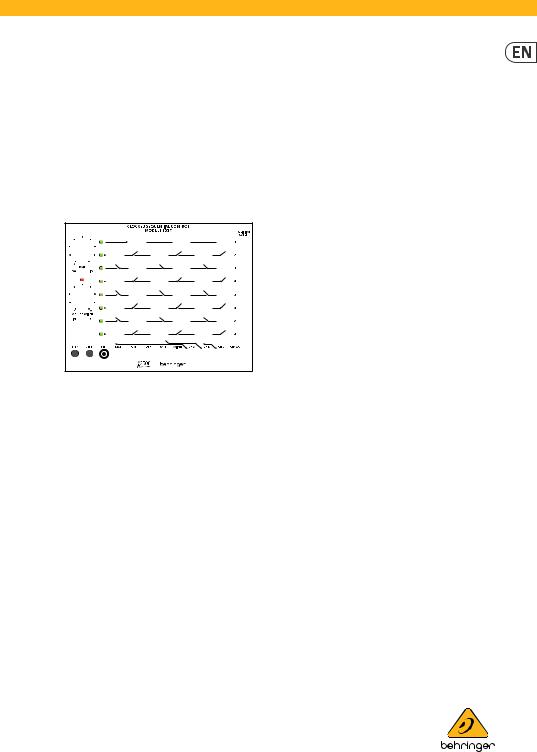Behringer 1027 Quick Start Guide

Quick Start Guide
CLOCKED SEQUENTIAL CONTROL MODULE 1027
Legendary 2500 Series 8-Position Step Sequencer Module for Eurorack
Controls |
|
|
|
|
|
(2) |
(1) |
|
(3) |
(4) |
|
|
|
|
(5) |
|
|
|
|
(6) |
|
|
|
|
(7) |
|
|
|
|
(8) |
|
|
|
|
(9) |
|
|
|
|
(10) |
|
|
|
|
(11) |
(12) (13) (14) (15) (16) (17) |
(18) |
(19) (20) |
|
(1)CH A / CH B / CH C SEQUENCER COLUMNS – Use the knobs to set the control voltage output for each step. Each column sends out control voltages via that channel’s respective CH A / CH B / CH C output jack.
(2)STEP LEDs – Each LED lights to indicate its respective sequencer step is active.
(3)POSITION GATES – Each of these output jacks sends out a gate signal for its respective sequence step via cables with 3.5 mm TS connectors. These 8 gate output signals are also available via the 12-pin GATE OUT LINK CONNECTOR located on the module underside. This 12-pin connector can connect to and trigger other compatible modules, such as the MIX-SEQUENCER MODULE 1050, via a 12-pin ribbon connector.
(4)RATE – This knob controls the step speed at which the sequencer moves from step to step. The knob operates in two overall frequency ranges determined by the LOW/HIGH switch.
(5)LOW/HIGH – Use this sliding switch to set whether the RATE knob operates in a lower-frequency (LOW) or higher-frequency (HIGH) range.
(6)% PULSE WIDTH – Select between width settings
for the rectangular waveform ranging from 5% to 95% duty cycle. The PULSE WIDTH control operates on the CLK OUT jack only, making this control very useful for triggering other modules such as envelope generators, and so on.
(7)INT/EXT – Use this switch to select between internal (INT) or external (EXT) pulse width control voltage. When EXT is selected, the % PULSE WIDTH control knob is disabled.
(8)ON /OFF – This button starts or stops the sequence with a manual button push.
(9)STEP – Press this button to manually progress to the next sequencer step.
(10)RESET – Press this button to manually restart the sequence at step 1.
(11)STEP – Use this jack to route external trigger signals for the STEP button into the module via cables with 3.5 mm TS connectors.
(12)RESET – Use this jack to route external trigger signals for the RESET button into the module via cables with 3.5 mm TS connectors.
(13)ON – Use this jack to route external trigger signals to enable the step counter into the module via cables with
3.5mm TS connectors.
(14)OFF – Use this jack to route external trigger signals to disable the step counter into the module via cables with
3.5mm TS connectors.
(15)RATE – Use this jack to route in external control voltage signals for the sequencer's step speed (usually controlled by the RATE knob) via cables with 3.5 mm TS connectors.
(16)WIDTH – This jack allows control voltage and modulation signals for the rectangular waveform to be routed in via cables with 3.5 mm TS connectors.
(17)CH A – This jack sends out control voltage signals for the CH A sequencer column via cables with 3.5 mm TS connectors.
(18)CH B – This jack sends out control voltage signals for the CH B sequencer column via cables with 3.5 mm TS connectors.
(19)CH C – This jack sends out control voltage signals for the CH C sequencer column via cables with 3.5 mm TS connectors.
(20)CLK OUT – Use this jack to export the internally generated clock signal via cables with 3.5 mm TS connectors.
The internal clock produces a gate pulse every time the sequencer steps, and the gate pulse’s width can be adjusted using the % PULSE WIDTH control or via the WIDTH control jack.
V 1.0
